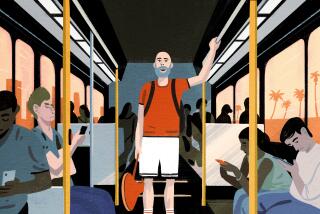City Seeks to Lure More Fairfax Trolley Riders
City officials hope to increase ridership on the 4-month-old Fairfax Trolley by cutting the fare in half, adding a second bus and launching a districtwide promotion campaign.
The proposed changes were prompted by concern that ridership “definitely is not looking full,” said Brian Davis, president of Pacific Busing Inc., which operates the service under a $25-an-hour contract with the city.
With city approval, the changes would go into effect when the current $60,000 contract, which will go out for rebidding in March, expires June 30.
While as many as 90 people a day rode the bus in December, business dropped off after the holidays and only now is starting to rise again, Davis said.
Average ridership for the 21-seat trolley was 70 passengers a day in mid-February, according to Alisa Katz, an aide to Councilman Zev Yaroslavsky.
Colorfully Painted
The bus, brightly painted to resemble a turn-of-the-century trolley, now runs at half-hour intervals along a route beginning at Melrose and Fairfax avenues and proceeding south to 3rd Street, west to Robertson Avenue, north to Beverly Boulevard, east to San Vicente Boulevard, north to Melrose and west to Fairfax.
Yaroslavsky’s office and the city Transportation Department are considering cutting the 50-cent fare in half and introducing a discounted monthly pass for senior citizens, who make up three-fourths of the riders.
Adding a second bus would cut the interval between rides to 15 minutes, Davis said.
Officials are planning an advertising campaign to familiarize residents with the service, which began Oct. 29.
They also are considering issuing tokens to merchants who would hand them out to customers. “Let’s say you go to your local business, to your local kosher butcher, and he says, ‘Good, you bought four pounds of flanken (flank steak). Here’s your token for the trolley,” Yaroslavsky’s aide said.
May Serve More Areas
Also, plans call for extending service to Pan Pacific Park and the library and community center on Gardner Street once the new contract begins, Katz said.
Funded by the 0.5% sales tax for transportation approved by city voters as Proposition A in 1980, the service was started as an experiment despite objections of the Southern California Rapid Transit District, which was serving the area.
Jim McLaughlin, a city traffic engineer, said the convenience of the route should make it competitive with the RTD, which requires a number of transfers to cover the same streets.
“We feel another year will give a better indication if this is a substantive program or merely a window-dressing type of thing,” he said.
More to Read
Sign up for Essential California
The most important California stories and recommendations in your inbox every morning.
You may occasionally receive promotional content from the Los Angeles Times.










